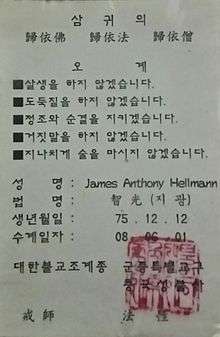Buddhist initiation ritual
The lay Buddhist ordination (Chinese: 受戒; pinyin: shòu jiè, Japanese: Jukai (受戒), Korean: sugye (수계) refers to the public ordination ceremony wherein a lay follower of Buddhism receives certain Buddhist precepts.[1] The particulars of the ceremony differ widely by country and by school of Buddhism.
| Part of a series on |
| Zen Buddhism |
|---|
 |
|
Persons Chán in China Classical
Contemporary
Zen in Japan Seon in Korea Thiền in Vietnam Zen / Chán in the USA Category: Zen Buddhists |
|
Doctrines
|
|
Awakening |
|
Practice |
|
Schools
|
|
Related schools |
Japan
In Japan, the ritual is called jukai.
Sōtō school
In the Sōtō school in the United States, lay initiates take refuge in the Three Jewels (or Three Refuges--Buddha, Dharma and Sangha), the Three Pure Precepts (to do no harm, to do only good, and to do good for others) and the Five Grave Precepts--Affirm life: do not kill; Be giving: do not take what is not freely given; Honor the body: do not engage in sexual misconduct; Manifest truth: do not speak falsely; and Proceed clearly: do not cloud the mind with intoxicants.[2]
South Korea

In South Korea, the ritual, called sugye (수계), involves formally taking refuge in The Three Jewels of Buddhism: the Buddha, the Dharma, and the Sangha, and accepting the five precepts. During the ritual, the initiate is touched with a burning incense stick. This is to leave a permanent mark which serves to remind the initiate of their promise to uphold the five precepts. During (or right after) the ceremony, the initiate is given a Buddhist name.[4]
China
In China, the ritual, is called shòu-jiè (受戒). The character 受 means "receive," while 戒 means "precepts." Taken together, the characters translate as "initiated" or "ordained."
Many people believe in Buddhism but do not go through any initiation ceremonies. Such Buddhists make up the overwhelming majority. Only a small part of Buddhists have gone through the ceremony which makes the recipient an upasaka or upasika and accepted the five commandments. They are formal Buddhists.[5]
Lewis Hodous, in his 1920 book Buddhism and Buddhists in China remarks on the Chinese ceremony as well, after recording an initiation ceremony for both those entering monastic life and the laity: "Less private was the initiation of the lay brethren and sisters, more lightly branded on the right wrist, while all about intoned 'Na-mah Pen-shih Shih-chia-mou-ni Fo.' (I put my trust in my Original Teacher, Säkyamuni-Buddha.)"[6] In modern notation and Chinese, this would be written "Namo Benshi Shijiamouni-Fo" (南無本師釋迦牟尼佛).
United States
In the United States, "jukai is a formal rite of passage that marks entrance into the Buddhist community. At that time, a student is given a Dharma name. He or she also makes a commitment to the precepts, which are interpreted a bit differently in various communities."[7]
In the Diamond Sangha, jukai is "commonly practiced" though some members never undergo the ceremony because they are members of another religion which prohibits such initiations. Therefore, some would say, they are not Buddhist by definition.[8]
At the Rochester Zen Center and its affiliated centers, the jukai ceremony involves taking the same precepts as in the Soto and White Plum traditions; however, from school to school or lineage to lineage, interpretation and translation of precepts can vary.[9]
The White Plum Asanga follows the same ritual as the Japanese Soto-school.
Notes
- Johnson, 55
- Lay Initiation Ceremony: Receiving Soto Zen Buddhist Precepts (Jukai), Atlanta Soto Zen Buddhist Center, American Soto Zen Buddhist Association
- "Shoken and Jukai". Archived from the original on 12 February 2017. Retrieved 11 February 2017.
- Hellmann, web
- Ling, 184
- Hodus, 13
- Seager, 109
- Spuler, 67-68
- Chodron, 124-125
References
- Bodiford, William M. (1993). Sōtō Zen in Medieval Japan. University of Hawaii Press. ISBN 0-8248-1482-7.
- Chodron, Thubten (2000). Blossoms of the Dharma: Living as a Buddhist Nun. North Atlantic Books. ISBN 1-55643-325-5.
- Hellmann, Tony (October 30, 2009). "Buddhist Rites of Religious Initiation". Jumping the Asymptote. Retrieved November 13, 2009.
- Hodus, Lewis (1924). Buddhism and Buddhists in China. New York: The MacMillan Company. OCLC 1081492.
- Johnson, Fenton (2003). Keeping Faith: A Skeptic's Journey. Houghton Mifflin. ISBN 0-618-00442-4.
- Ling, Haicheng (2004). Buddhism in China. Chinese Intercontinental Press. ISBN 7-5085-0535-2. OCLC 62320660.
- Olson, Phillip (1993). The Discipline of Freedom: A Kantian View of the Role of Moral Precepts in Zen Practice. State University of New York Press. ISBN 0-7914-1115-X.
- Seager, Richard Hughes (1999). Buddhism In America. Columbia University Press. ISBN 0-231-10868-0. OCLC 40481142.
- Spuler, Michelle (2003). Developments in Australian Buddhism: Facets of the Diamond. Routledge. ISBN 0-7007-1582-7. OCLC 49952207.
Further reading
- Loori, John Daido (1996). The Heart of Being: Moral and Ethical Teachings of Zen Buddhism. Charles E. Tuttle. ISBN 0-585-06814-3. OCLC 42855782.
External links
- "Korean Sugye Ceremony Photo Gallery" (in Korean). Cheontae Order. 2 July 2008. Archived from the original on 2011-07-25. Retrieved 13 November 2009.